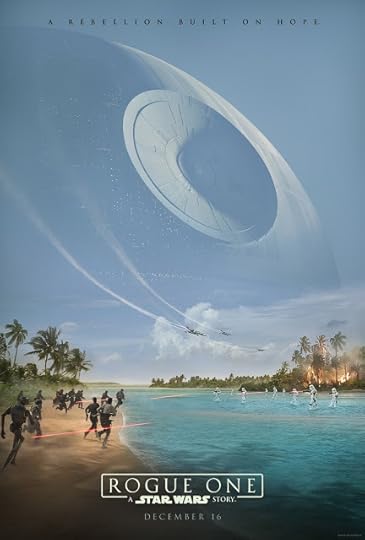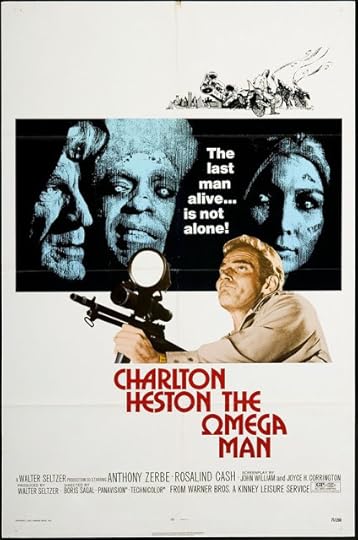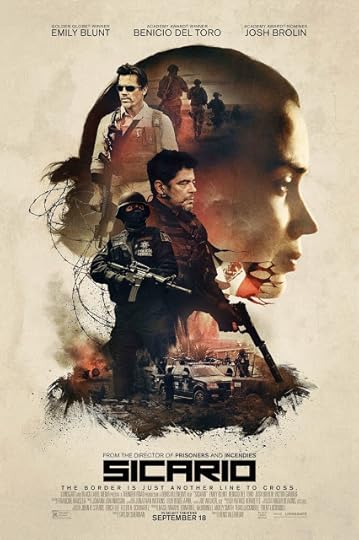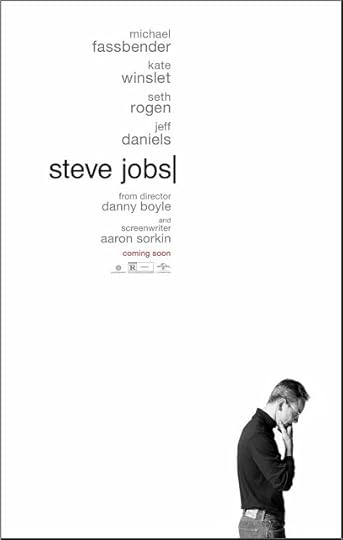Movies I Watched in December, Part 3
Finally (finally!) wrapping up the last movies of 2016...

Er, spoilers, I guess?
I’m torn on this one, I really am. On the one hand, I realize that a big chunk of the film was, as they say, “fan service,” little tidbits from the old (I’m tempted to say “actual”) “Star Wars” films -- glimpses of the Death Star coming together, Artoo and Threepio, a whole lot of Grand Moff Tarkin, a tiny peek at Princess Leia (the poignancy of seeing this right before her death made the janky CGI a little easier to swallow) and, of course, Darth Vader. (More on him in a bit.) The rest of the movie was a bunch of characters I didn’t care about doing something I knew they’d succeed at. (Though, admittedly, I was surprised not a single one made it out alive – and I admire the movie for taking advantage of that opportunity.) I like the idea of “Star Wars” movies going beyond the people and stories we know to tell some other tales of life under the Empire, I really do. The trouble is, I wasn’t made to care about any of these characters, and I could barely remember even their names once the end credits rolled. Having a strong female character at the center of a “Star Wars” movie is a fine idea (though Princess Leia was no pushover herself), but the key is to make sure she's an interesting character – otherwise, who cares? About any of them, male, female or robot? That, in a typically roundabout way, brings me back to why I’m torn on "Rogue One." I hate the idea of being played like a Stradivarius by filmmakers who sprinkle in those Easter eggs, knowing the 10-year-old “Star Wars” fan deep inside me will respond, but the truth is, that’s what I responded to in “Rogue One” – in fact, looking back, it’s just about the only thing I responded to. It was a two-hour, 13-minute movie, but all I can remember now – and remember fondly – are those few seconds of Vader rampaging through a crew of anonymous rebels handing off the Death Star plans. That’s the scene that thrilled me. In fact, those anonymous rebels – lacking any backstory whatsoever but loaded with determination, desperatation and self-sacrifice – were the most compelling characters in the movie.

I ask, is there anything more enjoyable than watching vintage 1971 Charlton Heston tooling around the empty streets of Los Angeles in a bright red gas guzzler, picking at the remains of what’s left of the human race? If there is, I don’t want to know about it. This adaptation of Richard Matheson’s durable “I Am Legend” isn’t perfect, but Heston was at his cocky best in 1971, with “Planet of the Apes” a few years behind him and “Soylent Green” a few years ahead. You can’t help but admire the life he’s carved out for himself as the supposed last man on Earth, screening “Woodstock” so often he knows the stage banter by heart (consider that nightmare for a moment) thenretiring at night to his apartment fortress to play chess with a mannequin and blast his spotlights at the invading vampire/zombie/hippie horde. Naturally, he’s not really the last man on Earth (they never are), and between the vampires/zombies/hippies and the beautiful babe (Rosalind Cash, doing a brief nude scene my family did NOT expect to see on Turner Classic Movies), things get a little crowded before the suitably downbeat/upbeat ending. Anthony Zerbe adds to the fun as the surprisingly philosophical leader of the vampire/zombie/hippie hordes, but it’s Heston who brings it. Boy, does he bring it.

Watched this one partly because I’d heard raves, partly because I’d just seen director Denis Villenueve’s new movie, “Arrival,” and partly because I’ve always enjoyed the work of its stars, Emily Blunt, Josh Brolin and Benicio Del Toro. It’s pretty damned good – not quite on the level of “Arrival” – but well worth checking out. Following the complex (both morally and logistically) efforts of various government agents to combat the Mexican drug trade, it’s essentially a series of great scenes tied together by some slightly less great moments. Still, it maintains an impressive tension throughout, and those great scenes are genuinely great --- the opening is startling and the much-lauded scene involving a traffic jam at the border is one of the best single sequences I’ve seen in a while. Well worth a look, in other words.

I stumbled onto this one on HBO a few weeks ago, and I'm glad I did. Though director Danny Boyle had been hit-and-miss, to say the least, and writer Aaron Sorkin has been more miss than hit, this odd little star-studded biopic plays to both their strengths. The reason genius is in the structure of Sorkin's script, which avoids the life story route and instead focuses on three moments in Job's life: the introduction of the Mac, the introduction of the NeXT computer and the introduction of the iMac. Even better, it doesn't focus on those grand public scenes themselves. Instead, we see Jobs (Michael Fassbender -- excellent) getting ready for those spectacles as a variety of employees, old friends, old foes and estranged family members confront him backstage. This allows Sorkin to play to his strengths -- long, complicated conversations loaded with pre-show tension -- and lets Boyle avoid his weaknesses -- by keeping everything simple and confined, he's not allowed to go too far over the top, and instead adds a bit of visual excitement to what would otherwise be a pretty talky movie. The fact that all the reconciliation, public arguments and last-minute epiphanies are completely made up doesn't hurt the movie one little bit. In fact, it's good enough to have earned a spot on my semi-coveted Best Movies I Saw in 2016 list.

Er, spoilers, I guess?
I’m torn on this one, I really am. On the one hand, I realize that a big chunk of the film was, as they say, “fan service,” little tidbits from the old (I’m tempted to say “actual”) “Star Wars” films -- glimpses of the Death Star coming together, Artoo and Threepio, a whole lot of Grand Moff Tarkin, a tiny peek at Princess Leia (the poignancy of seeing this right before her death made the janky CGI a little easier to swallow) and, of course, Darth Vader. (More on him in a bit.) The rest of the movie was a bunch of characters I didn’t care about doing something I knew they’d succeed at. (Though, admittedly, I was surprised not a single one made it out alive – and I admire the movie for taking advantage of that opportunity.) I like the idea of “Star Wars” movies going beyond the people and stories we know to tell some other tales of life under the Empire, I really do. The trouble is, I wasn’t made to care about any of these characters, and I could barely remember even their names once the end credits rolled. Having a strong female character at the center of a “Star Wars” movie is a fine idea (though Princess Leia was no pushover herself), but the key is to make sure she's an interesting character – otherwise, who cares? About any of them, male, female or robot? That, in a typically roundabout way, brings me back to why I’m torn on "Rogue One." I hate the idea of being played like a Stradivarius by filmmakers who sprinkle in those Easter eggs, knowing the 10-year-old “Star Wars” fan deep inside me will respond, but the truth is, that’s what I responded to in “Rogue One” – in fact, looking back, it’s just about the only thing I responded to. It was a two-hour, 13-minute movie, but all I can remember now – and remember fondly – are those few seconds of Vader rampaging through a crew of anonymous rebels handing off the Death Star plans. That’s the scene that thrilled me. In fact, those anonymous rebels – lacking any backstory whatsoever but loaded with determination, desperatation and self-sacrifice – were the most compelling characters in the movie.

I ask, is there anything more enjoyable than watching vintage 1971 Charlton Heston tooling around the empty streets of Los Angeles in a bright red gas guzzler, picking at the remains of what’s left of the human race? If there is, I don’t want to know about it. This adaptation of Richard Matheson’s durable “I Am Legend” isn’t perfect, but Heston was at his cocky best in 1971, with “Planet of the Apes” a few years behind him and “Soylent Green” a few years ahead. You can’t help but admire the life he’s carved out for himself as the supposed last man on Earth, screening “Woodstock” so often he knows the stage banter by heart (consider that nightmare for a moment) thenretiring at night to his apartment fortress to play chess with a mannequin and blast his spotlights at the invading vampire/zombie/hippie horde. Naturally, he’s not really the last man on Earth (they never are), and between the vampires/zombies/hippies and the beautiful babe (Rosalind Cash, doing a brief nude scene my family did NOT expect to see on Turner Classic Movies), things get a little crowded before the suitably downbeat/upbeat ending. Anthony Zerbe adds to the fun as the surprisingly philosophical leader of the vampire/zombie/hippie hordes, but it’s Heston who brings it. Boy, does he bring it.

Watched this one partly because I’d heard raves, partly because I’d just seen director Denis Villenueve’s new movie, “Arrival,” and partly because I’ve always enjoyed the work of its stars, Emily Blunt, Josh Brolin and Benicio Del Toro. It’s pretty damned good – not quite on the level of “Arrival” – but well worth checking out. Following the complex (both morally and logistically) efforts of various government agents to combat the Mexican drug trade, it’s essentially a series of great scenes tied together by some slightly less great moments. Still, it maintains an impressive tension throughout, and those great scenes are genuinely great --- the opening is startling and the much-lauded scene involving a traffic jam at the border is one of the best single sequences I’ve seen in a while. Well worth a look, in other words.

I stumbled onto this one on HBO a few weeks ago, and I'm glad I did. Though director Danny Boyle had been hit-and-miss, to say the least, and writer Aaron Sorkin has been more miss than hit, this odd little star-studded biopic plays to both their strengths. The reason genius is in the structure of Sorkin's script, which avoids the life story route and instead focuses on three moments in Job's life: the introduction of the Mac, the introduction of the NeXT computer and the introduction of the iMac. Even better, it doesn't focus on those grand public scenes themselves. Instead, we see Jobs (Michael Fassbender -- excellent) getting ready for those spectacles as a variety of employees, old friends, old foes and estranged family members confront him backstage. This allows Sorkin to play to his strengths -- long, complicated conversations loaded with pre-show tension -- and lets Boyle avoid his weaknesses -- by keeping everything simple and confined, he's not allowed to go too far over the top, and instead adds a bit of visual excitement to what would otherwise be a pretty talky movie. The fact that all the reconciliation, public arguments and last-minute epiphanies are completely made up doesn't hurt the movie one little bit. In fact, it's good enough to have earned a spot on my semi-coveted Best Movies I Saw in 2016 list.
Published on January 27, 2017 09:03
No comments have been added yet.
Will Pfeifer's Blog
- Will Pfeifer's profile
- 23 followers
Will Pfeifer isn't a Goodreads Author
(yet),
but they
do have a blog,
so here are some recent posts imported from
their feed.



